A Smattering of Sexbots
Sexbots are as ubiquitous today as Starbucks. My Google news feed overruns with stories on sexbot brothels. No modern genre, especially animated ones, can feel properly inclusive without a sexbot gumming up the moral works, which in some cases might not be a euphemism.
‘Twasn’t always so. Sexbots go back a surprisingly long way in the arts but were seldom allowed to explicitly ply their trade after a spectacular introduction. They appear for the first time, as far as I can discover, exactly where stereotypes suggest: in the France where ladies don’t wear pants, the underground world of Parisian pornography.
You’ve never heard of Alphonse Momas, and not merely because he wrote under a zillion pseudonyms, but during his free hours from his job at the Seine prefecture, he was the leading purveyor of pornography to fin de siècle France. Millenials didn’t invent sex and neither did the baby boomers. Momas’ titles are like a catalog from the modern explicit upwelling of anything goes 1970s porn: Mistress of His Son, The Notebooks of Miss Callypia, The Woman with Dogs, Bloody Buttock, Fetish Lovers, The Eater of Men, The Virgin Fall.
And in 1899 La Femme Endormie (The Sleeping Woman), which he credited to “Madame B***, attorney.”
A kindly soul had invented the dildo for women deprived of male contact; for the pleasures of our brave Captain Pamphile [an adventure hero from Alexandre Dumas], someone had brought forth the rubber woman; for our hero, a deft craftsman, an artist, would invent a miraculous Phrynée [a famously beautiful Greek courtesan] he would be able to manipulate at will – she would always be compliant and silent, no matter how lewd the act he chose to perform.
Much lewdness follows.
Momas is properly dealt with in my forthcoming book on robots, where a full chapter on sexbots is appended. No book can ever be complete. Here are three of my favorites I had to leave out.
When casting about for the utter antithesis of explicit French pornography, many possible candidates proffer their halos. One about as unlikely was the response to the bloody and sexy comics berated by politicians and puritanical elders, the first issue of Mad, the original Mad comic book of 1952. All the stories were written by Harvey Kurtzman, each a parody of a genre: crime, horror, western, and science fiction. (It didn’t sell. The parodies of individual characters started in Mad #2 with Tarzan and these would be far more successful.) The knowing science fiction spoof was titled “Blobs,” drawn by Wally Wood.
Both Kurtzman and Wood grew up with comic books, which in the 40s regularly offered heavy doses of science fiction and the other genres alongside the superheroes, and both would have been heavy readers of the science fiction pulps. “Blobs” is a loving recreation of a type of Gernsbackian futurism, extrapolation a trend to its logical (and often illogical) conclusion. In its future world of 1,000,000 A.D., all manual tasks have been superseded by machines; humans, their every need catered to, are so weak they can’t leave their motorized chairs. “Our muscles have shrunk! Our bodies have withered! We’re just a bundle of nerves! We are blobs, I tell you! Blobs of flesh!” [bolding in original] Wall*E stole from the plot of “Blobs” with both hands. Except for one tiny detail. Disposable dames.
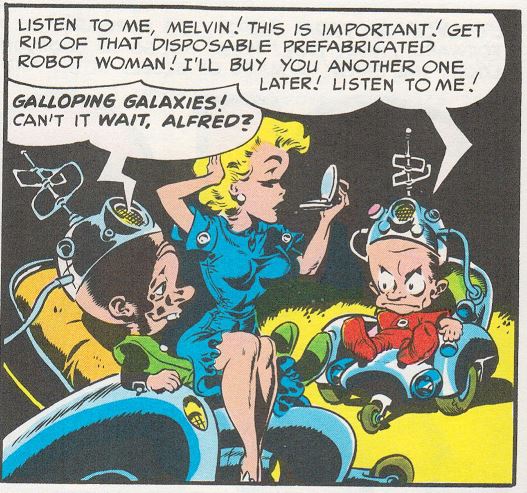 |
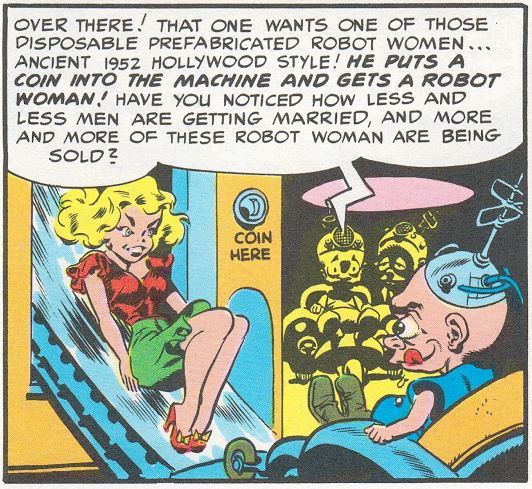 |
Technological obsolescence was the heavyweight theme of deep thinkers in the 1950s. Mad #1 appeared almost exactly contemporaneously with Kurt Vonnegut’s Player Piano, which also asked what worth humans had if they did nothing. Kurtzman couldn’t have known about the book, but he surely read E. M. Foster’s classic “The Machine Stops” because his hands were busy stealing from it. “Blobs” ends by asking “what if the machine that repairs the machine … breaks?” [italics in original] Answer: all humanity dies. Fun for everyone! Little wonder that Mad needed time and a different focus before its sales started zooming.
Kurtzman was a stellar parodist because he was steeped in white bread middle class American culture. His 1,000,000 A.D. future is 50s America with better gadgets but exactly similar social norms. (Exactly like 1950s print sf, admittedly.) That America was equally steeped in the norm that females were eye candy, housewives rather than doers, interchangeable and disposable, expressed only as cheesecake. Kurtzman’s sexbots are representative of the type, at first glance the ultimate expression of male fantasy, compliant and silent through unspeakable lewdness. That speaks only of humans. Robots themselves have no inherent sexuality. They are merely tools adaptable for the purpose at hand. A reimagining was inevitable and the rebellious 1960s the time. The place? You can guess the answer. France.
Jean-Claude Forest, born in 1930, was only six years younger than Kurtzman but lived in a different world. France imported only a small fraction of the vast numbers of comic books that were Kurtzman’s lifeblood and disdained those, producing a censorship law against comic book excesses years before the American crackdown. Forest moved into science fiction illustration, first for Fiction magazine, the French edition of The Magazine of Fiction and Science Fiction, and then cover art for Hachette’s science fiction imprint Le Rayon Fantastique.
The years of immersion in science fiction led almost inevitably to the comic strip that made Forest world-famous. Georges H. Gallet was editor not only of Le Rayon Fantastique but also the adult, male-oriented V-Magazine. He solicited a comic strip from Forest, “no holds barred.” The Spring 1962 issue featured the first serialized segment of “Barbarella.” The unearthly beautiful earthgirl is fearless and unconquerable, battling evil in all its guises, championing the downtrodden, and dethroning tyrants. No man can successfully oppose her, although some women are her equals. She is the emancipated woman ahead of her time, before Modesty Blaise and Emma Peel, free of spirit and of body. Michael O’Donoghue’s adventure spoof “The Adventures of Phoebe Zeit-Geist” was birthed by Barbarella when the editor of Evergreen Review asked for a strip in a similar vein. (Phoebe goes through a randomly episodic series of captures and tortures exactly like Barbarella’s except that she actually dies from them. Halfway through. Her dead body becomes the heroine of the second half. When people refer back to a Golden Age of “black humor” Phoebe Zeit-Geist is the darkest example. Dissertations could be written about what and who the focus of the satire is. and whether O’Donoghue is or isn’t as culpable as his evildoers, a discussion that needs to start with Forest.)
As with these other strong women, Barbarella’s beauty of face and body is constantly remarked upon and used for the male gaze, yet internally presented less for vanity than as a useful tool to seduce and infiltrate as well as provide herself pleasure. Compare her, though, to Harvey Kurtzman’s creation in late 1962, Playboy’s Little Annie Fannie. Kurtzman’s Annie is a naive airhead floating often naked and unaware through a technicolor wasteland of cultural satire; Forest’s Barbarella is brilliant and sophisticated in black and white, often lost on a hideously menacing alien world, but always quick to take command and turn the tables.
Consequently, she often requires rescue. A convenient air taxi swoops down to take her away from evil Queen Slupe. The pilot is Diktor, a robot, who reacts to Barbarella exactly like everybody else on the planet who is not trying to kill her.
What is Diktor able to do? “Everything, madame, everything… and with great care!” [italics in original]
It’s impossible to believe that the writers weren’t thinking of this scene when in season one of Star Trek: The Next Generation they wrote this scene between Data and Tasha Yar.
Tasha: You are fully functional, aren’t you?
Data: Of course, but-
Tasha: How fully…
Data: In every way, of course. I am programmed in multiple techniques. A broad variety of pleasuring…
Roger Vadim’s movie version of Barbarella is not as awful as it’s often described, but Jane Fonda’s Barberella is not Forest’s. Fonda was fated to play to role, though. Check this cover for Fiction #70, September 1959. I would swear that’s a portrait of Fonda, except that she was a total unknown at the time. (Yet she studied in Paris in 1957. A chance encounter on the street? A remembered face? Kismet.)
One more homage to old-time science fiction arrived in theaters in 1974, apparently FedExed from the Oort Cloud, since it was filmed in 1971. Flesh Gordon is even more of a cult classic film than Barbarella, a tribute to American tastes and humor. The parody of Flash Gordon serials started life as hard-core porn back in the days when filmmakers were under the delusion that they could make porn mainstream. The X rating got dialed back to R over time, leaving only the superb stop-motion animation (done on a minuscule budget, yet) as a lure. American sensibilities are immediately signaled by the names used. Dale Arden is Dale Ardor. The planet Mongo is planet Porno, ruled over by Wang instead of Ming. Best of the worst is what’s done to Dr. Hans Zarkov, who transmogrifies into the sensational Dr. Flexi Jerkoff.
Wang thinks with his, um, wang and his diabolical plots center around such. Evil sexbots are an innovation, although Barbarella gets encased in an orgasm machine designed to kill her with pleasure. Wang intends for Flesh and Dale to get literally screwed by Wang’s killer rapebots.
These robots are not the swiftest, though nobody in the movie is: Flesh attacks the metal monstrosities by punching one in its steel back. Mr. Fantastic has a brain that can instantly work the controls of an alien spacecraft, but Flesh has pure dumb luck working for him. He spins an unlabeled control wheel, which somehow sends the sexbots after Wang, who escapes.
The Golden Age of sexbots thus ended with, appropriately, an anticlimax.
Steve Carper writes for The Digest Enthusiast; his story “Pity the Poor Dybbuk” appeared in Black Gate 2. His website is flyingcarsandfoodpills.com. His last article for us was Elementary, My Dear Metal Men.
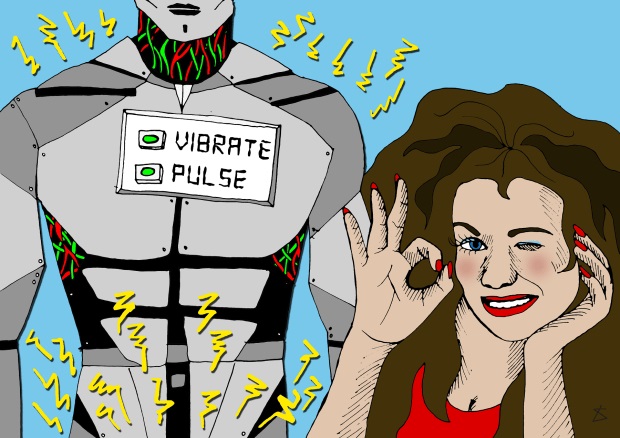
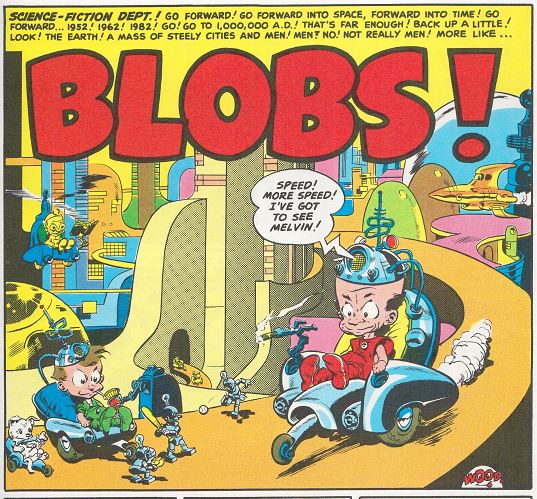
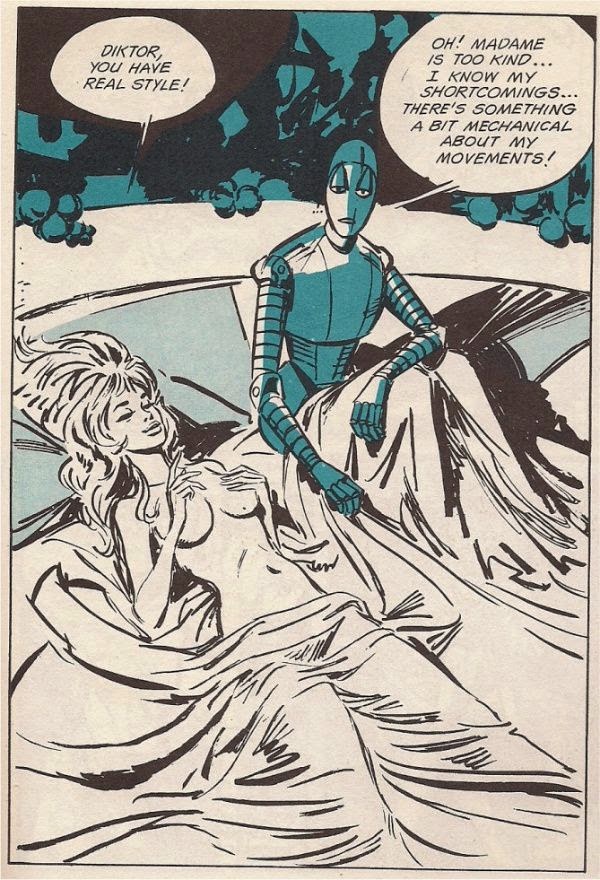
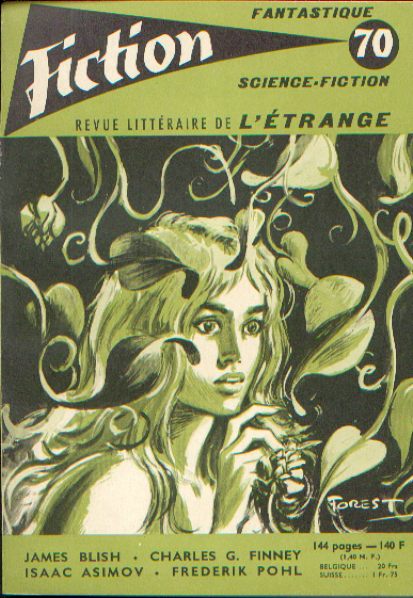
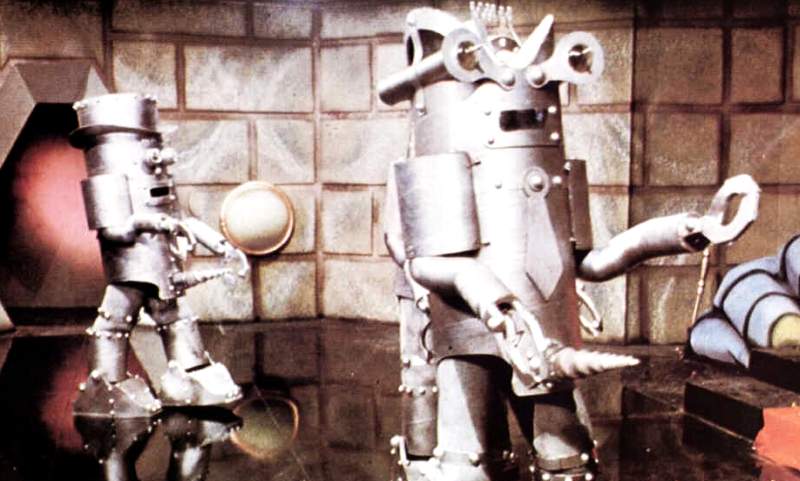
You need to put a filter on your Google Feed. I never heard the word “sexbot” until today, if it even is a word. Certainly NOT ubiquitous. Enjoyed the Wally Wood illos, though.
I’m afraid you’re way behind the times. Sexbot gets 931,000 hits on Google. More than a dozen books on Amazon have Sexbot in the titles. There is a music group called The Sexbots which have been around since at least 2011. The word obviously wasn’t new at that time, either. I seriously suggest checking Google News or an equivalent to see for yourself how ubiquitous the term is and how firmly embedded in reality it is.
I have a strong dislike for comics artist Howard Chaykin who seems to have picked up on all my favorites heroes (The Shadow, Blackhawk, Ruff and Reddy recently) and makes ‘updated’ versions of them as offensively as he can. I freely admit his art is very good. Tommy Tomorrow was an okay favorite as a kid due to his back-up status in World’s Finest Comics and then appeared now and again until Mr. Chaykin turned his attention to DC’s Science Fiction characters in a three issue min called Twilight. I read it ONCE–there is a one panel sexbot scene and the only real mercy I had form the series was Space Ranger was left alone. Lord knows what he would done to Cyrill the pink alien sidekick whose main power was to transform in to any creature that would pull the Ranger’s fat out of the fire. 🙂 Back about 2005 had to downsize the collection (Advice-never sell when you think you have an emergency-wait two weeks to see the need still exists-you only end up recollecting. I saw no need to recollect Twilight and I have refused to own Chaykin’s DC Shadow run–his recent series for Dynamite showed great restraint-so I did keep THAT one. The dislike for him truly started when I read an interview over the Blackhawk mini where he freely admitted he would be ticking off the old timers and seemed rather pleased about that.
I liked this article – here are my thoughts. Forgive the length, its meant as appreciation when I write so long a reply, and I try to delay a bit to not be ‘trollish’, but it ‘got me thinking’.
Sci-Fi was essentially G-rated for decades after the Govern-NOT threatened to crack down on “Spicy” tales. There’s a neat article “Why there’s no Sex in science fiction” in one of those montage books we grew up with at the local library, I’ll see if I can find it to cite.
Essentially got trapped between “Think of the Childreeeennn!” Scylla on one end and the illegal then kinda illegal then mainstream but too limited “Adult” audience Charybdis on the other. Further compounded by people who always screamed about the percentage and treatment of women, minorities, other groups…etc. which led to writers just cutting out such issues not wanting the hassle. A Black Gate article a year or so back on some SJW screeching about the “Xanth” series illustrates this well. By the time it became more or less feasible to go into such territory again – the 60s – well like Comic Books crippled by the “Comics Code” so many stereotypes kept it in place for the norm even with writers and publishers pushing for an exception.
There’s plenty of ‘Sex-bots’ in fiction now and becoming closer to truth in RL.
My favorite is SkyDoll where the central character is such a being that develops a personality. The preface of the collection of the first work – Decade – has the artist pointing out that after a decade of working for Disney and just feeling ill from the pure evil had to write it as an expression.
Another cool one is “Malice@Doll” – you can usually find on YouTube but cheap DVD – was a computer animated experiment – about a very far future where humanity is missing but the robot servants remain maintaining the buildings and machinery of a long dead mankind. It focuses on the ‘red light’ district where dolls for said purpose wait forever with no humans coming for them to comfort, dealing with the issue that they are without purpose now.
I’m going to address such issues in my writings later on. My idea is to have different types of ‘sex dolls’ from cheap ones made in very questionable ways to very expensive ones that are advanced AI and require a year of programming to be mapped to the purchaser’s personality. Also there’s the ‘android’ that’s flesh and essentially a cloned slave versus a pure machine intelligence of a robot – and perhaps things in-between. Likewise there’s competition and conflict between different levels of sex dolls and also human women since men will mostly be buying them. And not just the “Machines r taken R Jerbs…” stuff. I like Clamp’s “Chobits” world of perscoms where women turned really NICE in the face of those things, wanting to attract men versus being thorny/mean with men constantly begging them for companionship as in the past. Lots of aspects to it – Futurama brilliantly went over that with a culture geared to reject love between organic and Robot.
I think the issue should not be so much to make a scifi about ‘sex dolls’ but rather have them as characters in any future – absolutely far future setting. If a far future setting does not, there does need to be a good explanation.
Like Star Wars… well beyond “Hey we are G rated, people…yes even with severed limbs and Twileks and that bikini Leia wore…”
1 – highly illegal due to culture and fear of bot takeover in ancient history/culture
2 – very difficult due to their tech and how it works
3 – they have an ‘outlet’ far cheaper – the Twilek
Laws in place to keep droids that mimicked real creatures banned severely. Also a decadent near Level 4 civ pretending to be Level 3 so their tech was so advanced it was VERY hard to do anything new or unusual with it. Grease monkey can play with couplings from a junkyard and get something to make NASA die of green envy, but can he extrapolate the parts to see how they work…nope… AND – in expanded universe canon the one time such a “Humanoid Android” was made, yep, she was some rich creep’s wanna-be ‘ultimate woman’… Spending enough to buy and maintain harem of hundreds of twileks, like 10 million standard credits when you could get poor Oola for C1000, or C10,000 if you don’t want to risk a frontier trip. Some Twi-Leks cost a LOT like the regal caucasian skinned one from Revenge of the Sith, but most are cheap and due to loosely enforced laws and super cheap travel any s-x outlet is done with slavery or at least ‘red light’ visiting – just kept enough off camera to avoid issues with the movie ratings. In short, hard to make, legally troublesome and they don’t need the outlet. If I was in Star Wars I’d go the “Han Solo” route but get a Twilek as soon as possible – rescue, buy or just charm – they are capable of being mechanics and other trades, just nothing with high wisdom requirements and look cute in a flight suit.
Far future or long lived ultratech world you’ll get a menagerie of sex beings – just enough time, enough warped/lonely/rich beings with too much time and money on their hands – if at all possible (and much is in sci-fi) it’d be made. Plant/flesh fusions, up to mobile flesh/plant hybrids – in short ‘flower women’ – though that itself is ancient – the “Alraune” not modern like the “Floran” from Starbound. Engergy beings that might appear angelic. Countless “Chimera” perhaps the “Cat Lady” and the too cliche “Furry”. Utilitarian races/species – like the Star Wars Twi’lek come into play also – just look at how some ‘third world’ countries are used for ‘gentleman’s tours’ in RL.
I’d also include it into the future tapestry.
Imagine a sex-bot that gets passed through a household for several generations. First she was “Crazy uncle Ivan’s Scandal” but he had a controlling stake in the family corporation so they left him alone till the rejuve treatments failed hoping for a place in the will – which they got – but one that stipulated she was in the household…period. So she spent a few years more or less in the closet blanking her mind to not go unstable, wearing perhaps a futuristic by 80s imagining dress and getting dusted off now and again as the maids had rights and machines couldn’t take over some duties. Then in a “retro future Neo Victorian” outfit gets pulled to act as a “Nanny” since intelligent enough to do non sex tasks. Maids not used due to class corruption/labor rights info pollution. to the children just an “Auntie” reading them classic tales like when the young man from a desert world at last confronted his corrupted father on the weapon platform above a forest moon orbiting a gas planet… Then when the children grow up they insist on full family membership once they find out the truth. Better than demanding better rights for workers and F—ing the maid, the bot is certainly smart and mature enough to carefully push away and control any youthful ‘interest’. So she’s nobility now and quickly used -with consent – for a needed political/economic marriage – able to carry implanted children in an artificial womb – then later the family is broken up by massive interstellar wars they had no part in. Still immortal being going through a tech advanced pan-galactic civilization that either looks like a beautiful but ancient woman or perhaps a kind of clunky obvious sex robot but again some archaic clothes – use steampunk/victorian to argue age.
You could write a novel about this – or include this as a character in a larger epic. She could be a wild card in a galaxy full of wild characters. Perhaps a help, a love interest… or some kind of very deadly, capable villian working for revenge for a family forgotten in the diaspora. Yes, that last paragraph, use it if you feel like it, just don’t scream I stole “your” idea if I use it later it’d be my reward if I could help expand the ‘sex doll’ into a character archetype better than the one line joke/porn scifi stuff. My only advice is do NOT spend a page telling this at once – its done too often whole page describing the character, every bit the outfit as if were typing for a commissioned illustration, then their history hopes, fears dreams… Have it unfold in the story – the uncomfortable perhaps reality that such things will be created, the gradual impact at first shocking then part of society then just one facet of a world too vast to hold all at once.